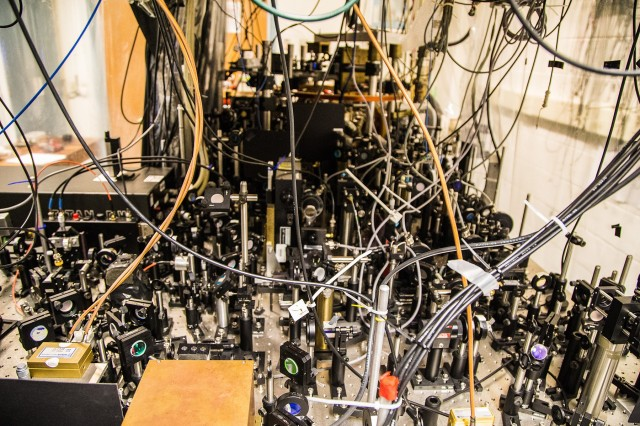Apr 15 2020
Scientists involved in a U.S. Army project have gained an important insight that could help develop quantum computers and quantum devices.
 A U.S. Army project conducted at Penn State discovered that a class of particles known as bosons can behave as an opposite class of particles called fermions, when forced into a line. This finding provides a key insight for the development of quantum devices and quantum computers. Researchers at Penn State use this apparatus to create an array of ultra-cold one-dimensional gases made up of atoms. Image Credit: Nate Follmer, Penn State.
A U.S. Army project conducted at Penn State discovered that a class of particles known as bosons can behave as an opposite class of particles called fermions, when forced into a line. This finding provides a key insight for the development of quantum devices and quantum computers. Researchers at Penn State use this apparatus to create an array of ultra-cold one-dimensional gases made up of atoms. Image Credit: Nate Follmer, Penn State.
The researchers identified that a class of particles called bosons can act similarly to an opposite class of particles known as fermions when compelled into a line.
The study was performed at Penn State University and was financially supported in part by the Army Research Office, an element of the U.S. Army Combat Capabilities Development Command’s Army Research Laboratory. The study was published in the Science journal.
As part of the study, the researchers identified that when the inherent interactions between bosons in a one-dimensional gas are very powerful, the distribution of their velocity changes into that of a gas containing non-interacting fermions upon extending in one dimension.
The performance of atomic clocks, quantum computers and quantum systems rely upon the proper curation of the properties of the chosen system. This research effort demonstrates that the system statistics can be altered by properly constraining the dimensions of the system.
Dr Paul Baker, Program Manager, Atomic and Molecular Physics, ARO
Baker continued, “In addition to furthering our understanding of foundational principles, this discovery could provide a method for dynamically switching a system from bosonic to fermionic to best meet the military need.”
Through experiments, the scientists showed that when bosons extend in one dimension—the line of atoms is permitted to spread out to become longer—they can develop a Fermi sea.
All particles in nature come in one of two types, depending on their spin, a quantum property with no real analogue in classical physics. Bosons, whose spins are whole integers, can share the same quantum state, while fermions, whose spins are half integers, cannot.
David Weiss, Research Team Leader and Distinguished Professor of Physics, Penn State University
“When the particles are cold or dense enough, bosons behave completely differently from fermions. Bosons form Bose-Einstein condensates, congregating in the same quantum state. Fermions, on the other hand, fill available states one by one to form what is called a Fermi sea,” added Weiss.
The researchers developed a series of ultracold one-dimensional gases composed of bosonic atoms (or Bose gases). They achieved this by using an optical lattice that employs laser light to capture the atoms. In the light trap, the system exists at equilibrium and the vigorously interacting Bose gases exhibit spatial distributions similar to fermions, but still contain the velocity distributions of bosons.
When a portion of the trapping light was shut off, the atoms tend to expand in one dimension. When this expansion occurs, the bosons’ velocity distribution seamlessly changes to be similar to those of like fermions.
By fully understanding the dynamics of one-dimensional gases, and then by gradually making the gases less integrable, we hope to identify universal principles in dynamical quantum systems.
David Weiss, Research Team Leader and Distinguished Professor of Physics, Penn State University
Dynamical and interacting quantum systems constitute a crucial part of basic physics. Moreover, they are highly technologically relevant because several real and proposed quantum devices, such as quantum computers and quantum simulators, are based on them.
According to professor Marcos Rigol, the other leader of the research team and professor of physics at Penn State, “We now have experimental access to things that if you would have asked any theorist working in the field ten years ago ‘will we see this in our lifetime?’ they would have said ‘no way’.”
Apart from ARO, the U.S. National Science Foundation financially supported this study.